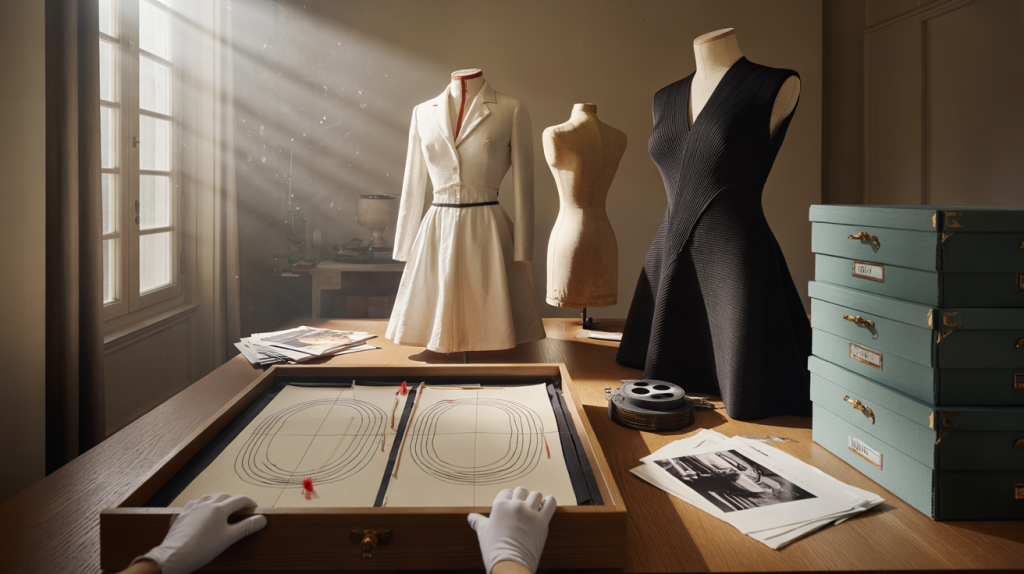Step inside the private worlds of Christian Dior et Azzedine Alaïa: how to access their archives, what they hold, and why they keep shaping fashion today.
Behind heavy doors in Paris, drawers glide open and two visions of elegance come back to life. Christian Dior’s sculpted waists, Azzedine Alaïa’s razor-sharp lines – preserved in personal archives that still steer the way we see fashion history.
These archives are not myth. Dior Heritage and the Fondation Azzedine Alaïa safeguard toiles, patterns, photos, runway films, even fitting notes that trace hand, eye, and cut. For anyone researching style, staging an exhibition, or simply trying to understand why certain silhouettes endure, this is where the evidence lives.
Dior Heritage and Fondation Azzedine Alaïa : why these personal archives matter
Here is the heart of it: archives turn intuition into proof. Dior’s house, founded in 1946, reshaped postwar fashion with the 1947 “New Look”. Azzedine Alaïa, trained in sculpture and celebrated from the 1980s onward, built garments that fit like architecture. Their personal materials show the exact decisions – the hidden stitches and corrected lines – that created those breakthroughs.
Researchers visit to verify dates, confirm authorship, and read the life of a garment from the inside out. Curators borrow pieces that become the spine of major shows. Designers return for references when the zeitgeist swings back to structure and purity. The public rarely sees the day-to-day holdings, yet the impact is visible on museum walls and, yes, on runways.
There is a practical barrier. Access is limited because conservation comes first. Fabrics are fragile; paper yellows; film degrades. But controlled access means continuity: what survived the 1940s, 1950s, 1980s – and 2017, the year Azzedine Alaïa passed away – will also speak to future generations.
From 1947 to 2017 : a timeline that explains the Dior – Alaïa connection
The link starts with method. In 1947, Christian Dior introduced a vision built on cut, proportion, and disciplined construction. That precision filtered through Paris ateliers for decades.
Azzedine Alaïa arrived in Paris in the late 1950s, learned the city’s couture rigor up close, then formed his own vocabulary in the 1980s. The body became the frame, seams became sculpture. He also collected historical garments obsessively, preserving knowledge others might have discarded.
After his death in 2017, the Fondation Azzedine Alaïa formalized the stewardship of his personal archive in Paris. On the Dior side, Dior Heritage had long centralized the maison’s memory, from 1946 forward. Side by side, these holdings map two complementary stories: one about the birth of modern fashion, the other about its most exacting cutter.
How to access these archives : museums, exhibitions, permissions
Dior Heritage remains a private resource for the house, scholars, and curators. General visitors meet the archive indirectly through exhibitions and loans. A notable example: the Musée des Arts Décoratifs in Paris staged the landmark “Christian Dior: Couturier du Rêve” in 2017, drawing from Dior’s holdings to show decades of couture in one narrative arc.
For regular public access, the Christian Dior Museum in Granville presents seasonal exhibitions drawing on Dior Heritage and external loans. In Paris, the Fondation Azzedine Alaïa mounts focused shows built from the couturier’s own collection and working materials, often highlighting technique over spectacle.
Researchers can request appointments – expect to document your project, outline specific needs, and follow conservation rules. For the general public, the smartest path is simple: track exhibition calendars, sign up for institutional newsletters, and plan visits around confirmed dates rather than speculation. When archives open a door, they do it with purpose.
What to look for inside garments and documents from Dior and Alaïa
When you do stand in front of a piece, context matters. Look past the surface and into the work.
- Seam architecture : where seams intersect tells you how volume is controlled.
- Foundation layers : Dior’s internal corsetry versus Alaïa’s stretch engineering signal different philosophies.
- Toiles and pattern marks : pencil corrections reveal last-minute choices that changed a line.
- Labels and show numbers : they anchor a garment to a date and collection.
- Fitting photos and film : posture, stride, and fabric behavior complete the picture.
The lesson becomes clear fast. Dior’s 1947 revolution reads in waist placement, hem width, and under-structure. Alaïa’s mastery shows where elasticity and seam direction channel the body’s movement. Both rely on a dialogue between hand and material – a discipline that, once seen up close, is hard to forget.
So the question many ask: can these archives still change how designers work now. Yes, when access is precise and contextualized. Museums translate fragile originals into public knowledge; scholars build timelines that hold up; designers learn what to keep and what to let go. The missing piece is not spectacle but metadata – captions that connect a garment to its toile, its fitting notes, and its runway moment. Get that right and the archive stops being a vault. It becomes a living adress book for fashion’s future.
